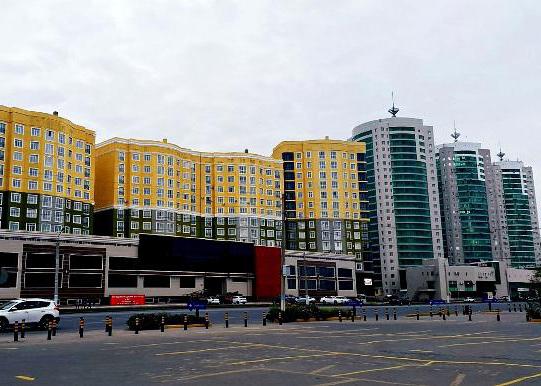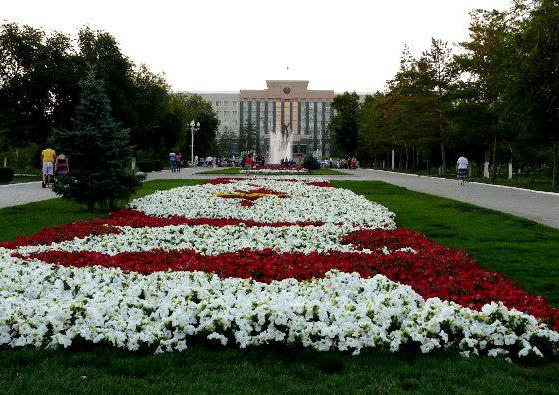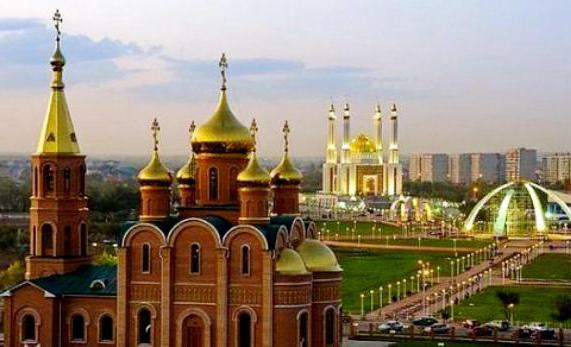In March 1999, a new city of Aktobe appeared on the maps of Kazakhstan and the world, the former Aktobe for more than a hundred years. The etymology of the name is based on a combination of the words “ak” and “tyube”, which means “white” and “hill” in the Turkic languages, respectively. Previously, one could also come across a name such as Belovershinsk. Cretaceous rocks, which come to the surface where the soil layer is destroyed by erosion, give color to the hill. The word “ak” can also be translated as “spiritually pure”, “innocent”, “undefiled”, which gives the name of the city a slightly different, majestic meaning.
Location
The city of Aktobe was founded on the left bank of a rather large (over 600 km long) tributary of the Urals - the Ilek River - in the area where the Kargaly River flows into it, but due to the steadily developing construction, it “crossed” the river and began to develop the right bank. It is approximately in the center of the Podural Plateau, in the northwestern part of Kazakhstan, near the border with Russia. To better imagine where the city of Aktobe is located, let us call its location relative to the nearest large settlements and objects. It is about 230 km from Orenburg, 500 km from Ufa, 430 km from Uralsk and 550 km from the nearest coast of the Caspian Sea. You can get to Aktobe by any means of transport - air, rail, road. The federal highway M32 (future A300), leading to the Samara and Orenburg regions, the A24 to Martuk and A27 to Atyrau pass through the city. In addition, through Aktobe laid the largest highway "Europe - Western China", which is called the "modern silk road."

The city has a large modern railway station, and about 4 km south is the new international airport.
A brief excursion into history
The city of Aktobe (Kazakhstan) once belonged to the Russian Empire. He grew out of the military fortification of Ak-Tyube, founded here in 1869 by two companies of foot soldiers and a hundred Cossacks, commanded by the count, who was in the rank of Adjutant Wing, von Borg. Before the arrival of the military, nomads lived here mainly engaged in cattle breeding. Not everyone was happy about the appearance of strangers. So, the detachment commanded by Bekbauov tried to conduct military operations against them, but after the first defeat from the Cossacks surrendered. Around the military fort, people gradually settled. By 1891, the settlement had grown so much that it received the status of a county town called Aktyubinsk. Its successful development was facilitated by the railway line, which appeared here in 1902 and connected the town with Tashkent and Orenburg. The development of industry also led to the emergence of a revolutionary-minded working class. Already in 1905 the party of the RSDLP was created in the city. After the revolution, Aktyubinsk several times passed from the hands of the Bolsheviks to the hands of the White Guards and vice versa, until, finally, on September 2, 1919, the Soviet government was finally established in the city with the support of the aviation of those years in the city. At first, Aktyubinsk belonged to the Republic of Kyrgyzstan, but in 1936, when the Kazakh SSR was formed on the territory of the RSFSR , it joined its composition. In 1990, Kazakhstan became an independent state, and after 9 years, Aktyubinsk received a new name - the city of Aktobe. For his not-so-long life, a lot of bad and good things happened. In the first years of Soviet power, when the young state was strangled from all sides, and it was incredibly difficult to get on its feet, Aktobe residents experienced hunger (1919-1922) - at that time, according to official figures, about 1000 people died. Further from mistakes in economics and politics, there was a second famine (1932-1933), which claimed the lives of about 4,500 citizens. There were so few products in those terrible years that people ate the bark of trees and clay, and there were cases (documented, by the way) that of each other. Despite these horrors, housing was being built in the city, water and electricity were being developed, and landscaping was being carried out. And only everything began to improve, as the war broke out. About a dozen plants and factories from Moscow, Zaporozhye, and Dnepropetrovsk were evacuated to Aktyubinsk. After the war, the rapid development of the economy of Aktobe began, large-scale construction of housing, expansion of the city's infrastructure. Almost all the objects created then function now.

Governing bodies
In Kazakhstan, the government is represented by the akimat, which governs the affairs of the state and is an independent executive branch, and maslikhat is an elected government expressing the will of the people. Deputies to each maslikhat are elected by the residents of the locality to which it belongs. Akimat (city administration) is formed by akims, and its structure is approved by maslikhat. The administrative apparatus includes deputies, employees of various departments, employees of the management of economic structures, resources, activities of enterprises and organizations. Akims of large territorial units (capital, regions) are appointed by the president. Akim of the city of Aktobe is appointed endowed with broader powers of the Akim of Aktobe region. The first in Aktobe was occupied by E. Sagindykov, Doctor of Economics, a person with extensive experience. Before becoming the head of the city administration, E. Sagandykov worked as a physical education teacher at the school, as a master of vocational training in vocational schools, then rose to leading posts in the field of vocational education. He managed to work in the regional committee of the CPSU of Kazakhstan, and also served as deputy minister of education and consultant in the Supreme Council. E. Sagandykov worked as Akim in Aktobe until 2004, until he received the post of head of administration of the entire Aktobe region. Now Akim of Aktobe is Bekbol Sagyn, a lawyer by profession, a bachelor. He was appointed to this high post in 2015. The akimat building is located on the central avenue named after Abilkayyr Khan (former Lenin Ave.).
Old part of town
There is an unofficial division into two almost equivalent parts of Aktobe - the Old City, located on the slope of Ak-Tyube, and Novy, the center of which is the most ambitious city avenue named after Abilkayir Khan. In the old part of the city there is a railway station. And the districts bear the following names: Moscow, Tatar (Tatar settlement), Kurmysh, Otorvanovka, Baby, Gormolzavod. It is dominated by private residential buildings and buildings on one floor. The Otorvanovka district appeared one of the first, back in 1887. He began to build up immigrants from the Astrakhan province. No less old is Kurmysh, named after the blacksmith Kurmys who once lived here. The lands on which it is located can be flooded by the rivers of Kargada and Ilek spilling into the flood. Kurmysh borders on the Shygys fair and market. The Moscow region comes close to the railway, and also adjoins the Bolshak microdistrict, which is considered promising in terms of development. The architecture of Aktobe is such that new skyscrapers and old buildings coexist peacefully and even create some kind of eclectic harmony. True, there are not many of them in the central part of the city. Among the existing ones, one can distinguish the Shahrezada restaurant, which is located in the building of the former female gymnasium, erected in 1894, and the Lokomotiv cinema, which was once the House of Culture of Railway Workers (built in 1928).

New part of town
Undoubtedly, the new city of Aktobe is the most beautiful and interesting. The photo captures one of the squares with the mosque in the evening lights. The new part includes the following areas: Shanghai, Ken Dala, Microdistricts (go under numbers), Sazdy and Bolshak. Microdistricts are located along the central avenue and are mainly built up with high-rise buildings, have a developed network of shops, banks, comfortable hotels offering world-class service, and other infrastructure. The central avenue houses the administration building, shopping centers, a stadium, banks, two mosques, and higher education institutions.
The farthest area in the New City is Shanghai. It is built mainly by one-story residential buildings.
In addition to the above, in Aktobe new areas appear with enviable consistency. Only recently, 30 units have been formed.
Infrastructure
The city of Aktobe, with a population of almost 400 thousand people, is a large metropolis with dozens of factories, factories and private enterprises. Among them are factories of X-ray equipment, ferroalloys, engineering (manufactures equipment for agricultural needs), distilleries, food, light and chemical industries. Cultural objects in Aktobe are represented by cinemas, a planetarium, libraries, of which there are 18 units, museums, theaters. The city has the Akhtanov Drama Theater, founded in 1935, the Alakai Puppet Theater, and the Regional Philharmonic. Education is provided by 6 universities, including the State University named after Zhubanova, Ospanov Medical University. According to the latest data, in Aktobe, 20.5% of the population had higher education. The health of citizens is monitored by employees of 29 hospitals and about 100 outpatient clinics and clinics. In Aktobe, much attention is paid to sports. The local football club, named after the city, won more than once in regional, regional and local football matches, became the champion of the country. In general, Aktobe is considered the most “football” city in Kazakhstan. Among the sports facilities there are several stadiums, tennis courts, a swimming pool, an ice palace, and fitness clubs. In Aktobe, public transport is well developed, represented by buses and minibuses, as well as taxis. There are no trolleybuses and trams here.
Climate
The zone on the continent of Eurasia, where Aktobe is located, is characterized by a sharply continental type of climate. This means hot summers, cold winters, the contrast between temperatures day and night, high levels of solar radiation and low rainfall. As to where the city of Aktobe is located - in Asia or in Europe, there is no consensus. If we consider the Ural mountain system as a border, then in Asia, if we draw it along the Caspian coast (as many geographers do), then in Europe. Regardless, in Aktobe in summer the temperature can reach +30 degrees and above, in winter it drops to -20 degrees, but there were years when in January the thermometer showed -48 . The monthly average rainfall is evenly distributed, very there are no rainy, nor very dry seasons. The number of sunny and cloudy days is also approximately the same and is respectively 174 and 148 days, plus 43 days with cloudy weather.
Water Resources and Beaches
The city of Aktobe has an unusually beautiful nature. The photo captures one of the corners in the park near the fountains. There are so many of them that even a fountain celebration is held on May 1. By the number of reservoirs, Aktobe can be called a city of not only white peaks, but also blue rivers. Built on the left bank of the Ilek River, he has already moved to its right bank. The city center is decorated with the Sazda River, on the north-western side it is washed by the waters of Ziniske, partly from the southern part - Tamda, which dries up in summer, and from the north - Peschanka. But that is not all. In the area of Kirpichnoy, the Butak River flows, which interconnects Aktobe with the village of Akzhar.
In addition to rivers, there are reservoirs near the city. One of the largest in the region is Aktobe, to which only 10 km from Aktobe. Even closer, 8 km from the city, there is the Sazdinskoye reservoir, the most popular among the townspeople. And the third, the largest in the region, is Kargalinskoye, but it is located more than 60 kilometers from Aktobe.
Such an abundance of water resources provides a unique opportunity for summer and winter recreation of citizens. Along the banks of the reservoirs, many tourist camps, boarding houses, and beaches are equipped. The most comfortable one is on the Sazdinskoye reservoir, where in addition to swimming areas there are sports grounds, a billiard room, a cafe, there are many water attractions. A good reputation is also at the Sayahat beach, where everything is elegant, beautiful, there is even a fountain with fish.
Aktobe City: Attractions
Since Aktobe is quite young, he is not particularly rich in historical and archaeological sites. Almost the most popular place for both citizens and tourists is the huge entertainment and at the same time shopping complex Nurdaulet, where there are about a hundred shops, pharmacies, cafes, attractions for children, a mini zoo. It is also notable for the fact that just one step away is one of the central mosques, also called Nurdaulet. The population of Aktobe, for the most part (73%), is Muslim, and at first not everyone welcomed the entertainment complex next to the temple of the Lord, but since, according to ancient traditions, markets were always located next to mosques, the townspeople gradually appreciated and approved this new architectural project. In addition to Nurdaulet, the city has a mosque Nur Gasyr - very beautiful, located on the central avenue. A museum of religious Muslim themes “Rukhaniyat” is working in its building, where unique copies of ancient books and objects sacred to Muslims are collected.
There are Orthodox churches in Aktobe, which are also of interest for their architecture. Among them, the St. Nicholas Gold-domed Cathedral stands out.
Those who are interested in the history of the city of Aktobe should look into museums, the oldest of which is Historical and Local Lore. It began operations in 1924 and contains dozens of unique exhibits.
In addition, the history of the city is captured in monuments and monuments, of which there are about three dozen in Aktobe.
The sights of the village include wonderful parks, boulevards, fountains, a planetarium, which for a long time was the only one in Kazakhstan.
Achievements and Challenges
Aktobe by the number of inhabitants takes 5th place in Kazakhstan. The symbol of the city is a tulip. The coat of arms of Aktobe has the shape of a circle, which means "perpetual motion." At its bottom is the name of the city, made in white, symbolizing purity and holiness. The blue background means the never-ending movement of water, the ornaments of yellow, green and red are the sun, nature and tulips. A griffin is placed in the center of the coat of arms, which in heraldry has always been a symbol of strength, speed, vigilance and power.
Aktobe is a multinational city. Most of all, Kazakhs (73%) and Russians (20%) live here. In addition to them, there are Ukrainians, Germans, Bashkirs, Tatars, Koreans, Moldavians, Bulgarians, Chechens, Armenians and representatives of other nationalities.
According to economic indicators, Aktobe firmly holds the 6th position in the country. Industry growth and wealth are inextricably linked. So, according to statistics, the average salary in Aktobe varies between 500-600 dollars, which is an excellent result.
Aktobintsy are famous not only for their labor achievements, but also for their achievements in the field of culture. The city is famous for the Sukhoi Music Festival, which presents an independent style in music.
Unfortunately, Aktobe is not without problems. The largest of them is environmental. It is caused by industrial enterprises in which high-quality water and air purification systems are not installed. Their activity has led to the fact that in some areas the norms of formaldehyde, nitrogen dioxide and some other chemicals are several times exceeded. In addition, waste from boron and chromium is discharged into the Ilek River every year. To cope with these problems and ensure further prosperity of the city, dozens of trees, thousands of flowers are planted in it every year, work is underway to update the treatment facilities.